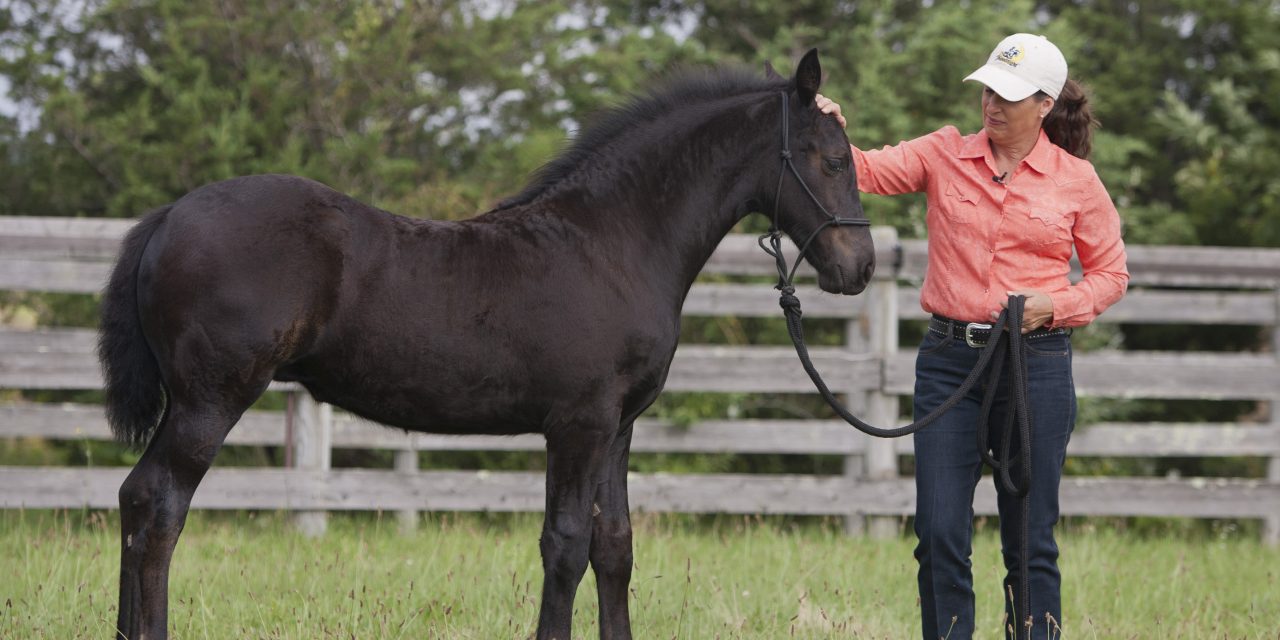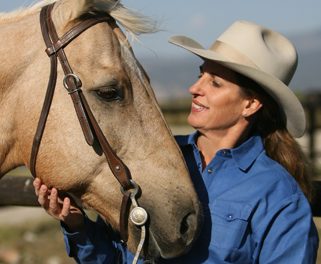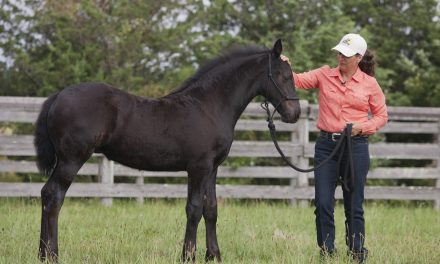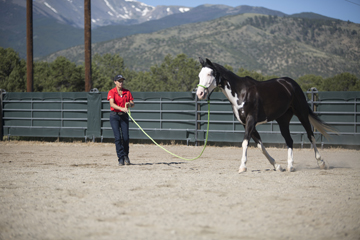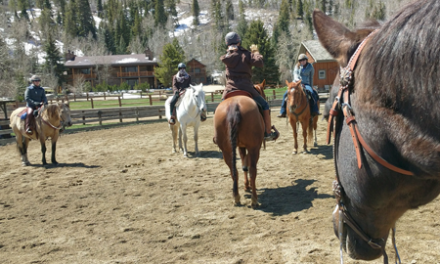Notes From Julie
 Are you raising a foal or young horse? Make sure you’re setting up a good relationship with respect from the start. To start your young relationship off on the right path, you’ll need to consider how a young horse thinks and envision how you want your horse to act later in life. All that training starts now. Your expectations must be clear and you must set about systematically to teach the horse what you think of as “good” behavior. In his young world, good behavior includes kicking, biting and running hell-bent for leather in any direction he pleases. That’s not how you want your young horse to act, so start teaching the new rules soon.
Are you raising a foal or young horse? Make sure you’re setting up a good relationship with respect from the start. To start your young relationship off on the right path, you’ll need to consider how a young horse thinks and envision how you want your horse to act later in life. All that training starts now. Your expectations must be clear and you must set about systematically to teach the horse what you think of as “good” behavior. In his young world, good behavior includes kicking, biting and running hell-bent for leather in any direction he pleases. That’s not how you want your young horse to act, so start teaching the new rules soon.
Horses know how to act like horses; that’s it. If we want them to act in certain non-horsey ways when we handle them, they have to be taught the proper response. We call that horse training. However, in the horse’s herd, he learns in the first days of life to recognize dominant horses and dominant behavior. He learns to respect authority and respect the space of others. He has trouble with the latter, even in the herd, so he gets spanked regularly (by kind but firm “aunties”). Because of this, young horses can be easily taught to respect your space and follow the rules. They can also be easily taught the opposite if mishandled.
I am not a big fan of over-handling baby horses—I’ve seen too many foals become insensitive spoiled monsters with many bad habits that must be “un-trained.” And I’ve seen how easily and quickly you can train 2 or 3 year olds that have never been handled; who have no preconceived notions about people. But, if you are going to handle young horses, there are basic manners and expectations of behavior that they should learn early on.
Spatial issues are huge with horses of any age. Just because the foal is young and cute, doesn’t mean he can’t run you down or kick your teeth out. Often, when inexperienced people are raising foals, big mistakes are made early on and the behaviors are well-engrained in the horse, long before the person has an appreciation for the scope of problem. Foals love to be rubbed and scratched and will quickly learn to lean and push on you to get your attention. Next thing you know, you have a horse that pushes you around and has learned to lean into pressure instead of move away from it. Those are bad traits when you’re riding a horse.
Because young horses are very oral by nature—constantly exploring their environment with their nose, lips and tongue—biting can be a big problem when handling youngsters. There’s a progressive set of behaviors in horses in which lipping behavior (when the horse puts his lips on you and nuzzles) leads to nipping (a small quick pinch with the teeth) leads to biting (the most aggressive and deadly behavior of horses). These are all progressive signs of dominance leading to aggression. If the lipping behavior goes unchecked, the horse begins to nip and if the nipping goes unchecked, he begins to bite. As the horse goes through this progressive behavior, he is simply testing his boundaries. Just as with human toddlers that may test out biting, this behavior should be “nipped in the bud,” as early as possible in the progression.
It has been my experience that people bring these behaviors on themselves by allowing horses to be in their space and by nuzzling, smooching and playing with the horse’s muzzle all the time. In the herd setting, there is a “linear hierarchy” which means that each and every individual of the herd is either dominant over or subordinate to each and every other individual. This means that between you and your horse, one of you’ll be the dominant leader and one of you’ll be the subordinate follower in your “herd of two.” It’s best to set this pattern early on in the relationship you are developing with your young horse.
If you establish basic rules of behavior (respect my space at all times, follow my lead, stop when I stop and stand still when I ask) and you correct him 100% of the time he makes an infraction, he will learn these important ground manners quickly. Also, any time any part of his body moves toward you, vigorously back him out of your space, so he learns where your space begins and ends. This will help him to learn to keep a respectful and safe distance from you and to be respectful of your space.
If you are raising a young horse or even retraining an older horse that missed out on learning good manners, it’s important to know what your expectations of his behavior are so that you can set clear rules and boundaries. If you’re not certain what your expectations should be, get some help. You only have one chance to make a good first impression on your horse.
Doing it right from the beginning may be critical in your horse’s success later in life. You have to be the leader and the enforcer and not coddle, cuddle or condone. When he is a teenager with 800 pounds of exuberance, you’ll be glad you did.
Want more young-horse help? Check out the Raised with Manners DVD and training tools package at http://shopping.juliegoodnight.com.
Enjoy the ride, Julie Goodnight
Julie Goodnight takes on topics you want to know more about in her online training library—part of her ever-expanding Horse Master Academy (http://signin.juliegoodnight.com). For more thoughts from Julie, watch her Horse Master TV show each Monday night on RFD-TV (now at 2 and 10 pm ET on RFD-TV!) or catch the show online anytime at TV.JulieGoodnight.com and please subscribe to the free Youtube channel at http://youtube.com/juliegoodnight.
Sign up for my free access and free monthly newsletter with more training tips>> http://horsetraininhelp.com. Goodnight is proud to recommend Myler Bits, Nutramax Laboratories, Circle Y Saddles, Redmond Equine, The Equine Feed Oat Project, Spalding Fly Predators, Bucas Blankets and Millcreek Manure Spreaders. Goodnight is the spokesperson for the Certified Horsemanship Association. Explore her online library and many training videos at http://tv.juliegoodnight.com; be sure to sign up for the free monthly training news at http://juliegoodnight.com and please subscribe to the free Youtube channel at http://youtube.com/juliegoodnight.

